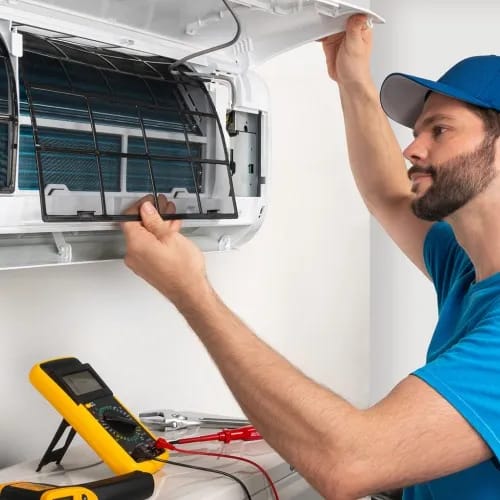Top 10 Flygt Float Switch Dealers in Dubai
Flygt float switches are essential components used to control the water levels in pumps and other systems, ensuring optimal performance in various applications, including wastewater management, sewage systems, and sump pumps. These switches are designed to automatically activate or deactivate pumps based on water levels, preventing overflows, dry runs, and other operational issues. Flygt, a trusted global brand, provides float switches known for their durability, precision, and reliability in demanding environments.
In Dubai, a hub of industrial and commercial activities, finding trustworthy Flygt float switch dealers is crucial for businesses and industries. These dealers ensure the availability of high-quality float switches that cater to a range of applications, from residential water tanks to large-scale industrial wastewater treatment plants. Whether you are seeking switches for new installations or replacements for existing systems, the availability of Flygt float switch dealers in Dubai makes it convenient to acquire these essential products. Flygt float switch dealers in Dubai offer a comprehensive range of products along with expert consultation, installation services, and after-sales support to meet the unique needs of each customer. As a result, businesses and households alike can rely on Flygt products to maintain proper water level control and ensure uninterrupted operation of their pumping systems.
· Mujahid Ali Ghulam Technical Services
Prime Business Center, Jumeirah Village Circle, Near Luxe Signature Holiday Homes LLC, Jumeirah Village, Dubai, 21537
· Binafix Technical Services LLC
F 74, Ahmed Building, 26th, Near Muraqqabat Police Station, Hor Al Anz, Dubai
· Ryan Technical Services
Al Khail Mall, Al Quoz, Near To NMC Amala Medical Centre, Al Quoz 4, Dubai
· KVC Technical Services Co LLC
Office 0438, Hamsah - A Building, 3 A Street, Near To Ansar Gallery Building, Al Karama, Dubai
· Ulti Trend Technologies
Office 505, Capital Golden Tower, Rich Rose In Same Building, Business Bay, Dubai, 450535
· Jashim Anjom Technical Services
Office No 2002, Al Qusais 2, Business Tower, Al Qusais, Dubai, 54545
· Mainstream Technical Services LLC
Obaid Mehayer Obaid Bin Suroor Warehouses, Dubai Investment Park 2, Behind Pepsi, Dubai Investment Park 2, Dubai
· Al Batal Al Saed Interior Decoration LLC
101, Shakhboot Building, Damascus Street, Opposite Emirates Building, Al Qusais Industrial Area 1, Dubai
· Ahmed Amin Technical Services
Shop No:6, Al Giryani Building, Al Nakheel, Near Fonax Hotel, Deira, Dubai
· Creative Space Interiors
Office 302, Al Raffa Building, Opposite New Grand Shopping Mall, Al Mankhool Road, Dubai
Float Switch Dealer: Comprehensive Guide in Dubai
Float switches are essential devices used to detect liquid levels in tanks, sumps, wells, and reservoirs. They play a crucial role in managing water levels, preventing overflows, and controlling pumps in various industrial, commercial, and residential applications. Float switch dealers provide a wide variety of float switches, catering to different needs, from simple mechanical models to advanced electronic versions. This guide covers everything you need to know about float switch dealers and includes answers to frequently asked questions.
Float switch dealers specialize in supplying float switches that help automate liquid level monitoring in a range of applications. These dealers offer different types of float switches, including mechanical, electronic, and mercury-free switches, to meet the needs of industries like wastewater treatment, manufacturing, agriculture, and home water systems. They also provide installation and after-sales services to ensure customers get the most out of their float switch solutions.
Types of Float Switches Available in Dubai
Float
switches are devices used to detect the level of liquid in tanks, reservoirs,
and other containers. They come in various types depending on their
construction, operation method, and application. Here are the main types of
float switches available:
1. Vertical Float Switch
- Design: These switches feature a
float that moves up and down along a vertical rod or shaft as the liquid
level changes.
- Operation: As the float moves, it
triggers a switch to either open or close a circuit, turning a pump or
valve on or off.
- Applications: Commonly used in sump
pumps, water tanks, and other applications where vertical movement is
needed.
- Material: Available in plastic,
stainless steel, or other corrosion-resistant materials.
2. Horizontal Float Switch
- Design: Mounted on the side of a
tank or vessel, with a float that extends into the tank.
- Operation: As the liquid rises, the
float pivots on a hinge, which activates the switch.
- Applications: Ideal for applications
with limited space at the top of the tank, such as in small tanks or where
side mounting is preferred.
- Material: Typically made from
plastic or stainless steel, depending on the liquid and environmental
conditions.
3. Cable-Suspended Float Switch (Tethered Float
Switch)
- Design: These switches are
suspended by a cable, and the float hangs in the liquid.
- Operation: The float tilts as the
liquid level changes, which activates or deactivates the switch. This
design allows for a wide differential between on/off levels.
- Applications: Commonly used in
wastewater treatment plants, sump pumps, and septic tanks, as they can detect
high or low levels.
- Material: Made from durable,
corrosion-resistant materials such as polypropylene or PVC for use in
harsh environments.
4. Magnetic Float Switch
- Design: Consists of a float
containing a magnet and a reed switch or sensor inside a sealed enclosure.
- Operation: When the liquid level
rises or falls, the float moves the magnet close to the reed switch,
either opening or closing the circuit.
- Applications: Often used in small,
precise applications like fuel tanks, water purification systems, or
chemical processing.
- Material: Typically made from
plastic or stainless steel to resist corrosion.
5. Tilt Float Switch
- Design: These are pendulum-style
switches that tilt when the liquid level changes.
- Operation: The float’s tilting action
opens or closes a contact, indicating a high or low water level.
- Applications: Commonly used in sewage
and wastewater systems, where solid materials might interfere with other
types of switches.
- Material: Often made of robust
materials like PVC to handle dirty or corrosive environments.
6. Mercury Float Switch
- Design: Contains a small amount of
mercury inside the float. As the float tilts, the mercury moves to open or
close the electrical circuit.
- Operation: Mercury’s movement inside
the switch creates or breaks the circuit, controlling pumps or valves.
- Applications: Used in industrial and
commercial applications, though becoming less common due to environmental
concerns.
- Material: Typically plastic or
stainless steel, though regulations have limited their use in many regions
due to mercury's toxicity.
7. Dual-Point Float Switch
- Design: These switches have two
floats, each for a different level, providing two set points for liquid
detection.
- Operation: One float triggers when
the liquid reaches a high level, while the other triggers at a low level.
- Applications: Ideal for controlling pumps,
allowing for automatic switching between filling and emptying modes,
commonly used in sump pits, wells, and tanks.
- Material: Available in various
materials including plastic, brass, and stainless steel.
8. Conductive (Non-Float) Level Switch
- Design: Technically not a
traditional float switch, this uses electrical conductivity to sense the
liquid level.
- Operation: Probes or electrodes
detect the presence of a liquid, triggering a signal when the liquid
reaches a certain level.
- Applications: Often used in highly
corrosive or viscous liquids where traditional floats may not perform
well, such as chemical tanks.
- Material: Corrosion-resistant
materials like stainless steel or specialty coatings.
9. Miniature Float Switch
- Design: Small, compact versions of
float switches that are typically used in tight spaces.
- Operation: Functions like other float
switches but with a much smaller footprint, suitable for low-volume liquid
containers.
- Applications: Commonly used in small
appliances, medical equipment, and automotive systems.
- Material: Usually made from
lightweight, durable plastics.
10. Optical Float Switch
- Design: Uses an optical sensor
instead of a mechanical float to detect liquid levels.
- Operation: A beam of light is emitted
within the sensor; when liquid reaches the sensor, the light is refracted
or reflected, triggering the switch.
- Applications: Ideal for detecting very
small changes in liquid levels, used in precision applications like
medical devices or laboratory equipment.
- Material: Often made from high-grade
plastic or glass for clear, precise liquid detection.
11. Differential Float Switch
- Design: Utilizes two floats that
detect both low and high liquid levels to control the operation of pumps.
- Operation: The switch activates when
the liquid level reaches the lower float and deactivates when it reaches
the upper float.
- Applications: Used in applications that
require a large difference between on and off points, such as in
stormwater management or large tanks.
- Material: Made of durable,
corrosion-resistant materials for use in harsh conditions.
12. Air-Pillar Float Switch
- Design: This type of switch
operates using a sealed air column that responds to changes in liquid
level.
- Operation: The pressure changes in
the air column caused by rising or falling liquid levels are used to
activate a switch.
- Applications: Suitable for environments
with thick or sticky liquids where traditional floats might fail, such as
in the oil and grease industry.
- Material: Constructed from robust
materials designed to withstand corrosive or viscous liquids.
Applications of Float Switches in Dubai
Float
switches are widely used across various industries and settings for liquid
level control, monitoring, and automation. Here are some of the key applications
of float switches:
1. Water Tanks and Reservoirs
- Application: Float switches are used to
monitor and maintain water levels in household, industrial, and commercial
water tanks and reservoirs.
- Purpose: Automatically control
pumps to refill or stop the inflow of water when the desired level is
reached, preventing overflow or dry running of pumps.
2. Sump Pumps
- Application: Sump pumps in basements or
low-lying areas use float switches to detect rising water levels during
flooding.
- Purpose: Activate the pump to
remove excess water and prevent flooding in residential and commercial
properties.
3. Wastewater Treatment Plants
- Application: In wastewater treatment
facilities, float switches are used to monitor and control liquid levels
in tanks, sumps, and sewage systems.
- Purpose: Control pumps, valves, and
alarms to ensure the proper flow and treatment of wastewater.
4. Septic Systems
- Application: Septic systems utilize
float switches to regulate liquid levels in septic tanks, ensuring proper
waste separation and drainage.
- Purpose: Prevent overflows and
trigger alarms when high or low liquid levels are detected.
5. Aquariums and Fish Tanks
- Application: Float switches help
maintain water levels in aquariums, ensuring the right amount of water for
aquatic life.
- Purpose: Automatically refill or
drain water and activate filtration systems, preventing water levels from
becoming too low or too high.
6. Boilers and Cooling Systems
- Application: Float switches monitor
water levels in industrial boilers, cooling towers, and heating systems.
- Purpose: Prevent damage to
equipment by maintaining the appropriate water levels, triggering alarms
or shutoffs when levels are too low or high.
7. Fuel Tanks
- Application: Fuel tanks in vehicles,
generators, and industrial machinery use float switches to monitor fuel
levels.
- Purpose: Prevent fuel shortages by
signaling low fuel levels and triggering refilling systems or alarms.
8. Irrigation Systems
- Application: Float switches are used in
agricultural and horticultural irrigation systems to control the water
levels in reservoirs and holding tanks.
- Purpose: Automate the irrigation
process by refilling water when levels drop and stopping when the tanks
are full.
9. Chemical Processing Plants
- Application: In chemical industries,
float switches monitor the levels of corrosive liquids, acids, or chemical
solutions in storage tanks and process tanks.
- Purpose: Ensure accurate liquid
levels for chemical reactions, processing, and safe storage, while
preventing spillage or leakage.
10. Oil and Gas Industry
- Application: Float switches are used in
storage tanks and processing equipment to monitor oil, fuel, and other
petroleum-based liquids.
- Purpose: Control pumps and valves
for loading, unloading, and transferring oil and gas, while preventing
overflows and spills.
11. Marine Applications
- Application: Boats, ships, and yachts
use float switches in bilge pumps to detect water ingress and
automatically pump it out.
- Purpose: Prevent the risk of
flooding by controlling bilge pump operation in response to water levels
in the bilge.
12. Home Appliances
- Application: Household appliances such
as washing machines, dishwashers, and water heaters use float switches to
monitor and control water levels.
- Purpose: Ensure correct water
levels during operation, preventing overflows or malfunctions.
13. Hydraulic and Pneumatic Systems
- Application: In hydraulic and pneumatic
systems, float switches monitor the levels of fluids used in the operation
of machinery.
- Purpose: Ensure consistent fluid
levels for proper equipment performance, avoiding damage due to low fluid
levels.
14. Food and Beverage Industry
- Application: Float switches are
employed in beverage dispensers, processing tanks, and bottling plants to
monitor liquid levels.
- Purpose: Automate filling and
dispensing processes, ensuring consistent levels in containers and tanks,
while preventing overflows or shortages.
15. HVAC Systems
- Application: Heating, ventilation, and
air conditioning (HVAC) systems use float switches to monitor condensate
levels in drainage pans.
- Purpose: Prevent water damage by
automatically draining the condensate and shutting off the system if
necessary.
16. Automotive Industry
- Application: Float switches in vehicles
monitor fuel, coolant, and oil levels in tanks and reservoirs.
- Purpose: Provide real-time monitoring
and feedback to drivers and systems, ensuring proper fluid levels for safe
vehicle operation.
17. Pharmaceutical Industry
- Application: Float switches monitor
liquid levels in pharmaceutical processing and storage tanks.
- Purpose: Ensure accurate
measurement and control of liquids used in drug production, maintaining
consistency and quality in processes.
18. Battery-Powered Systems
- Application: Float switches are used in
battery-powered sump pumps or emergency systems to control water levels in
case of power failure.
- Purpose: Automatically switch
between battery power and main power to ensure continuous operation,
particularly in critical environments.
19. Rainwater Harvesting Systems
- Application: Rainwater harvesting
systems utilize float switches to monitor water levels in collection tanks
and reservoirs.
- Purpose: Automate the water storage
process by triggering pumps to distribute water or prevent overflow.
20. Medical Devices
- Application: Certain medical devices
use float switches to monitor and control liquid levels in dialysis
machines, sterilization equipment, and other healthcare systems.
- Purpose: Ensure precise control of
fluids for patient safety and optimal machine performance.
Services Offered by Float Switch Dealers
Float switch dealers typically offer several services, including:
·
Product Consultation: Dealers
provide expert guidance in selecting the right float switch for specific
applications, considering factors like liquid type, tank size, and control
system requirements.
·
Customization: Many dealers
offer customized float switches tailored to meet the specific needs of
industries or individual clients.
·
Installation and Setup: Dealers
often provide installation services to ensure the float switch is properly
installed and integrated with the existing control systems.
·
Maintenance and Troubleshooting:
Some dealers offer ongoing support, maintenance, and troubleshooting services to
ensure optimal performance and longevity of float switches.
Factors to Consider When Choosing a Float Switch Dealer
When choosing a float switch dealer, consider the following factors:
·
Product Range: Ensure the
dealer offers a variety of float switches to meet your specific requirements,
whether it's a basic mechanical switch or a high-tech electronic version.
·
Reputation: Check customer
reviews, testimonials, and the dealer’s track record to ensure reliability and
product quality.
·
Customer Support: Choose a
dealer that offers excellent customer support, including product consultations,
installation, and after-sales services.
·
Customization Options: If you
have specific requirements, ensure the dealer can provide customized float switches
or tailored solutions.
·
Pricing and Warranty: Compare
prices across different dealers and check whether they offer a warranty on
products and services.
Frequently Asked Questions About Float Switch Dealer in Dubai
Q1: What is a float switch, and how does it work?
A1: A float switch is a device used to detect the level of liquid in a tank or reservoir. It works by floating on the surface of the liquid, rising and falling as the liquid level changes. When the liquid reaches a certain level, the float activates or deactivates the switch, which can control a pump, alarm, or other equipment.
Q2: What are the most common types of float switches available?
A2: The most common types of float switches are mechanical float switches, electronic float switches, vertical float switches, horizontal float switches, mercury-free float switches, and multi-level float switches. Each type is suited for different applications and environments.
Q3: How do I choose the right float switch for my application?
A3: The right float switch depends on factors such as the type of liquid, the size of the tank, and the application’s specific needs. For instance, mercury-free switches are preferred for environmental safety, while multi-level switches are ideal for monitoring different liquid levels in complex systems.
Q4: Can float switches be used in hazardous environments?
A4: Yes, certain float switches, especially those designed for industrial and hazardous environments, are rated for use in explosive or chemically aggressive settings. Be sure to choose a float switch with the appropriate certification for hazardous environments.
Q5: Do float switches require maintenance?
A5: Float switches generally require minimal maintenance, but it’s essential to check them periodically to ensure proper functioning. In some cases, debris or mineral buildup can affect their performance, so cleaning or inspecting the switch occasionally is recommended.
Q6: Can I install a float switch myself, or do I need a professional?
A6: While basic float switches may be easy to install, it is advisable to consult a professional for more complex setups, especially if the float switch is part of an industrial process or connected to automated control systems.
Q7: What’s the difference between a vertical and a horizontal float switch?
A7: Vertical float switches are mounted in a vertical position inside the tank and move up and down with the liquid level, while horizontal float switches are mounted on the side of the tank. The choice between the two depends on the tank’s size, shape, and space constraints.
Q8: How long does a float switch last?
A8: The lifespan of a float switch depends on factors such as the environment, the type of liquid it monitors, and the quality of the switch. Generally, a well-maintained float switch can last for many years.
Q9: Are there float switches designed for dirty or corrosive liquids?
A9: Yes, float switches designed for dirty or corrosive liquids are available. These switches are made from materials resistant to corrosion and are often equipped with special coatings to prevent damage from harsh liquids.
Q10: Can a float switch be used to control multiple devices?
A10: Yes, certain float switches can be integrated with control systems to manage multiple devices, such as turning a pump on and an alarm off simultaneously when the liquid reaches a specific level.




































